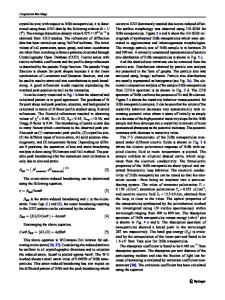Synthesis of In 2-x Ge x O 3 nanopowders for thermoelectric applications
- PDF / 577,789 Bytes
- 6 Pages / 584.957 x 782.986 pts Page_size
- 78 Downloads / 353 Views
Shekhar D. Bhame and Emmanuel Guilmeaua) Laboratoire CRISMAT, UMR 6508 CNRS-ENSICAEN, 14050 Caen Cedex, France
Frédéric Boschini and Rudi Cloots Laboratoire LCIS-GREENMAT, University of Liège, Chemistry Institute B6, 4000 Liège (Sart-Tilman), Belgium (Received 23 May 2011; accepted 12 September 2011)
Bulk ceramics In2 xGexO3 have been synthesized in air by using citrate gel process. Nanoparticles of less than 20 nm have been synthesized through an accurate control of the processing parameters. X-ray diffraction and scanning electron microscopy studies confirmed that the solubility limit of Ge in In2O3 (xℓ) is very small and that additions of more than about 0.5 at.% Ge lead to the presence of In2Ge2O7 inclusions. Thanks to a high interdispersion of metal ions and homogeneity in elemental composition of the nanopowders obtained by citrate gel process, well-dispersed In2Ge2O7 secondary phases can be formed in the Ge-doped In2O3 matrix. An abrupt increase in the electrical conductivity and in the carrier concentration with x is observed in the monophasic region (x , xℓ), whereas in the biphasic region (x . xℓ), these values do not vary significantly. Similarly, the thermopower |S| value is correlated to this variation decreasing as x increases for x , xℓ. Above the solubility limit, the decrease in the lattice thermal conductivity is shown to be dependent on the presence of well-dispersed In2Ge207 secondary phases. The dimensionless figure of merit value is increased up to 0.3, thanks to electron doping and phonon scattering. I. INTRODUCTION
Over the past decade, thermoelectric devices have been deeply studied as new no-waste energy sources.1 Thermoelectric devices allow the direct transformation of a heat source into an electrical current (Seebeck effect), and vice versa (Peltier effect), without using mechanical moving parts. By this way, thermoelectric devices are high durability systems for cooling/heating capacity. These devices can be used for promising applications such as the recycling into electricity of the large lost heat energy produced by automobile, manufactories, or incinerators. The performance of a thermoelectric material is determined by the value of the dimensionless figure of merit, ZT 5 S2T/qk, where S is the Seebeck coefficient or thermopower, q the electrical resistivity, and k the thermal conductivity. The ratio S2/q corresponds to the power factor (PF). Present research efforts are focused on developing new materials with high figure of merit preferably close to 1 or higher. In this context, oxides are being explored as suitable materials for thermoelectric applications at high temperature in air due to the high chemical stability at elevated a)
Address all correspondence to this author. e-mail: [email protected] DOI: 10.1557/jmr.2011.386 500
J. Mater. Res., Vol. 27, No. 2, Jan 28, 2012
http://journals.cambridge.org
Downloaded: 17 Jun 2014
operational temperatures. These materials have the additional advantage to be generally composed of nontoxic elements, contrary to certain conve
Data Loading...











